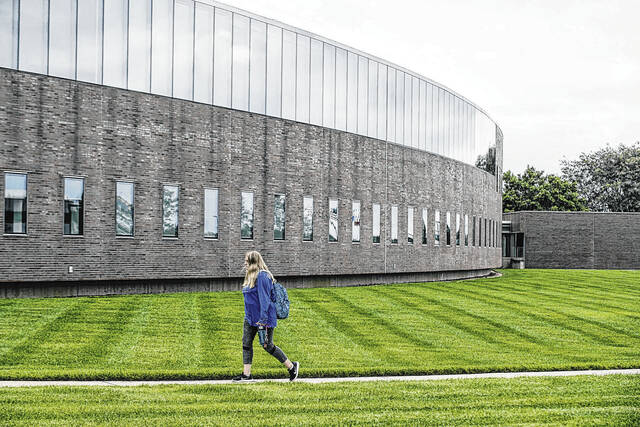
Indiana University-Purdue University Columbus student Abby Sallee walks past the Columbus Learning Center on her way to class in Columbus, Ind., Wednesday, Oct. 10, 2018. The learning center is shared by IUPUC and Ivy Tech.
Republic file photos
Designers for the Columbus Airpark landscape design project recently presented a more concrete concept of their ideas to local college and community leaders.
Landscape architecture firm Gustafson Guthrie Nichol (GGN) met virtually with community stakeholders on Nov. 1 to present the beginnings of their airpark framework and gather more input. The meeting was last of three public engagement sessions the firm has held this fall.
“I just remain grateful for the combination of inspiration, big thinking together but also the realism and down-to-earth nature of the folks in these conversations,” said GGN founding partner and design principal Shannon Nichol at the session’s end. “So somehow, it’s really true that Columbus seems to have this dual capability of having big ideas and being really comfortable pushing boundaries and trying new things, but also being really aware of what can really happen and realistic limitations and applicable ideas.”
GGN was announced as the landscape design partner for the project in June. It was selected from a group of four firms recommended by the Cummins Foundation’s architecture program. The foundation is providing a grant for a “design framework” for the campus and a detailed design for its southwest corner.
During the Nov. 1 session, GGN representatives recapped takeaways from previous sessions, presented project goals derived from public input and presented initial concepts for a campus framework. Attendees then moved into breakout rooms to answer prompts and provide feedback on what they’d seen.
As part of the firm’s presentation, Nichol discussed four layers or “ingredients” that could make up the campus framework: new connections, new kinds of spaces, new complimentary programs and new production for Columbus.
“We like to think of the design of the landscape as being like these layers that we stack up over the ground,” she said.
In discussing the first layer of connections and circulation, Nichol said that improving accessibility might be one of the first steps for the airpark campus’s evolution.
“We could do the most beautiful landscape there, but if people can’t get to it and don’t feel they’re welcomed, that’s not serving the purpose of Columbus, the vision that you all have had,” she said.
For the layer regarding spaces, Nichol presented a preliminary concept for a series of smaller places that could provide opportunities to “wander.”
One visual of these areas was broken down into green spaces, representing more parklike spaces, and pink spaces, which Nichol said could have “more of a village feeling.” The latter locations could also connect more to nearby buildings and neighbors and potentially become “dense with buildings.”
This division also carried over to the programming layer, with more village or “urban” programs potentially located on the east and south and more outdoor or nature-oriented programs on the north and west edge.
Nichol highlighted this concept of “the village and the park” as a major principle of the framework.
“Any college campus that’s in a community like this in America or even elsewhere needs to serve both of these functions to connect to the community and be a place for the whole student,” she said. “So the neighborhood feeling and that dense sense of community — dense meaning lots of people and activities — that sort of ideal feeling of what a main street sort of feeling can be in the village portion. And then also serving as a green space and a space for mental health and respite.”
With the production layer, Nichol displayed potential projects the campus could produce, particularly in terms of supporting sustainability.
“What is happening in the ground, how is it treated if it’s not lawn or massive plazas?” Nichol said. “…In some ways, the purpose of this framework plan is not to prescribe program. We’re setting up the framework for anything to happen here. And yet, we want an idea of what could happen, what kind of partnerships could happen so that we’re designing the framework appropriately.”
She added that the firm still has a lot of work left to do.
“We are working over the next several weeks, looking to wrap up right before Thanksgiving, putting together that final thinking on the framework package to give to our campus partners, developed along the way by all of your critical feedback,” said GGN Project Manager Alex McCay.
Once individuals had been split up into breakout rooms, Nichol asked her group about their first impressions and reactions to the presentation.
Columbus Area Chamber of Commerce Membership Director Bob Schafstall said that while there are some aspects that he might need further clarification on, he liked the “feel and the ideas” and thinks the concept is “just what we need.”
“I like the idea that we’re getting away from the monument campus and trying to bring it in and make it more personal,” he said. “…It’s just neat to have the idea of having a place for people to go and actually use the space.”
Schafstall added that he’s very interested to see what happens with the southwest corner of campus. He joked that part of the undertaking with that section will be to “make it look like we didn’t just have a bomb go off and a building is missing” after Poling Hall is demolished.
Nichol said that they would begin “more specific site design” on the corner that week. They’ve been working outward from the new Ivy Tech building and now need to work from the southwest corner “in toward the campus.”
Ivy Tech Columbus Site Director Erica Speers, who assists with the college’s facilities, said that school officials are excited about the future of the southwest corner and how it can be a “brand new entrance into the airpark campus.”
“We’re going to have this beautiful facility, this brand-new building, and we’re super excited, just really, to tie it all together,” she said. “And so we appreciate your hard work.”
Other topics of discussion included possible future developments that could help bring more people to the airpark area, how to change the parking setup while still serving drivers’ needs, and how the People Trail might be incorporated into the campus design.
Participants also discussed the importance of drawing more people to the campus and how the framework might contribute to that need.
Landmark Columbus Executive Director Richard McCoy touched on the “growth space” mentioned by GGN. He said that in order to attract use from nearby neighborhoods, this would need to be a “worthwhile space” that is attractive enough that walkers are willing to travel through other places they find less interesting.
“What’s going to cause a student to want to linger?” he added. “To get there half an hour early or an hour early to hang with their buds. … How do you find a space that causes people to linger?”
“That’s the challenge of landscape as catalyst,” agreed Nichol. “… It’s often easy to think of landscape by itself without retail, without restaurant, without those kinds of hard program. It’s easy to think, ‘Oh, people will come because it’s a park, or it’s green.’ And we know that that alone isn’t enough.”
She said that there needs to be a “minimum critical mass of both physical improvements and program investments” in order to reap a “minimum amount of draw.” Some initial ideas for attracting people include an informal performance space and a “standalone landscape experience” such as a park.
“Events, of course, don’t take the place of that daily vibrance that you’re talking about,” Nichol added, “but they can help. They can help rebrand a place as a place that you go in your community.”
Schafstall also noted that, in terms of branding, the idea of a more unified airpark campus is somewhat new, and it might help to have something “memorable” to drivers passing by.
“There’s a lot of people … when we talk about the Columbus airpark campus, they go, ‘Well, where’s that? What is that?’” he said.




